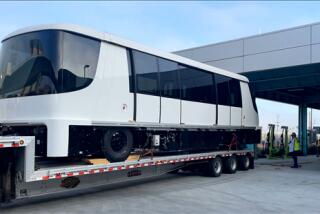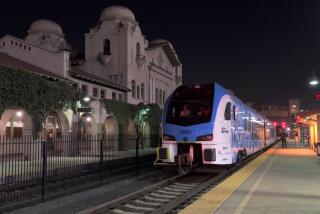Bullet Train Plans Aim at Florida Congestion
TALLAHASSEE, Fla. â Four companies seeking to build a state-of-the-art transportation system in Floridaâs congested corridors conjured images Monday of a bullet train that would whisk passengers at speeds of 150 to 250 m.p.h. along a Tampa-Miami route.
Company representatives envisioned sleek, high-technology trains that resemble airplanes in appearance, planned suburbs and cities springing up along the routes, and quiet and comfortable trips between Tampa and Miami that take only 90 minutes, regardless of the weather.
State officials attending the presentations were urged to think about the tourism boom, the business opportunities and environmental advantage of having a clean and efficient way of moving as many as 6 million people along routes between Miami, Orlando and Tampa every year.
Legislators Receptive
Legislative leaders seemed to like what they were hearing.
âFlorida was the first state to have a settlement in the new world, it was the site of the first moon launch, and now it will be the site of the first truly modern rail system in the world,â said House Speaker Jon Mills. âI think itâs symbolic of what Florida can become.â
Mills (D-Gainesville) attended the crowded presentation ceremony in Floridaâs Old Capitol along with Gov. Bob Martinez, Senate President John Vogt (D-Merritt Island) and officials of the rail commission.
The Florida High Speed Rail Transportation Commission was not expected to award a franchise until September, 1991, to allow time to study the project and its costs, which could run as high as $5 billion. The train linking Tampa, Orlando and Miami is expected to be running by 1995.
Links to 3 Cities
State guidelines mandate that the project must link the three cities, but the applicants will determine precise routes, financing agreements and the technology they will use.
The company that wins the franchise will be allowed to develop property next to the route for rail stations and connecting attractions. The idea is that those developmental rights will help the company recoup the start-up costs of building the rail system.
One of the four applicants was TGV of Florida Inc., backed by the French company Alsthom, which supplies TGV trains to the French National Railways, and Bombardier Inc., a Canadian manufacturing consortium.
TGVâs proposal for an electrified system would include trains that could run up to 185 m.p.h. and would cost several billion dollars.
Costs Vary
TGVâs big advantage is that the system in France has been very successful.
All American MagnePlane Inc. argued that its technology was newer, faster and cleaner environmentally. The magnetic-levitation trains, called âmag-levâ for short, would glide along a magnetic field along an elevated track. Because a magnetic force controls the movement of the train instead of electricity or diesel-powered engines, company officials said their system eliminates the dependence on oil.
That system also is expensive, in the neighborhood of $3 billion.
Two other companies, the Florida High Speed Rail Corp. and Stone & Webster Engineering Corp., have proposed plans for systems that run a little slower, in the neighborhood of 150 m.p.h., and cost less because they use existing transportation corridors.
Stone & Webster has submitted the lowest general estimate of cost, recommending that the system could be built for about $1 billion.
After judging the proposals on the basis of environmental effects, financial arrangements, growth patterns and technologies, the rail commission can recommend one, or none, of the applicants to the governor and Cabinet.
More to Read
Sign up for Essential California
The most important California stories and recommendations in your inbox every morning.
You may occasionally receive promotional content from the Los Angeles Times.










